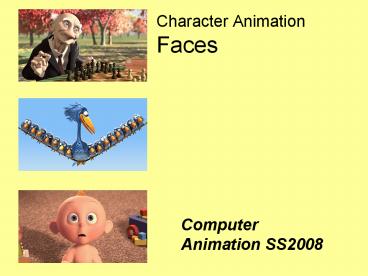Character Animation Faces - PowerPoint PPT Presentation
1 / 22
Title:
Character Animation Faces
Description:
Character Animation. Faces. Computer Animation SS2008. Facial Modelling ... Facial Expressions. Inner Brow Raiser. Frontalis, Pars Medialis. Outer Brow Raiser ... – PowerPoint PPT presentation
Number of Views:127
Avg rating:3.0/5.0
Title: Character Animation Faces
1
Character AnimationFaces
- Computer Animation SS2008
2
Facial Modelling
- Body components are often modelled using spline
meshes - Splines (bi-cubic paramaterized equations)
capture the curvature of surfaces
3
The Basic Technique
4
Create a Flat Mask
- Images can be used as templates for designing a
character - This is called rotoscoping
- Note how more curves are included for eye sockets
and mouth - This is only done for half of the face
5
Add Depth
- Once a flat, 2-D mesh is created using a front
view image, various points can be raised to add
depth - This is called lofting
- At this stage, additional control pints and edges
can be added
6
Extend Arcs to Back
- Once this mask has been created, various curves
are extended to form the back of the head - Additional curves are added, to complete the
heads mesh - But we still only have half of a head
7
Copy, Flip Attach
- Once a half head has been created, a copy is made
- This copy is then flipped along the X-axis
(mirrored) and attached to the original half
8
Skin
- Real skin is translucent
- Light is scattered through the various layers,
and reflected from a sub-layer - Bidirectional reflectance distribution
functions(BRDF) are often used
BRDF
No BRDF
9
Hair
- Difficult to model
- Techniques
- Individual hairs
- Hairs groups (clumps)?
- Particles
- Surface with texture mapping
10
HairHair Groups
- Hairs are divided into groups
- Each group is controlled by a singe vector
- In addition, hairs can be wavy/straight,
thick/thin, etc.
11
HairHair Groups
- A wet appearance can be achieved by clumping
hairs in a patch
12
Clothing
- Difficult to model
- May require physical model
- Techniques
- Surfaces with texture mapping
- Individual threads
- Others
13
ClothTypical Model
- Section of cloth is modelled as a polygonal mesh
- Edges are modelled as springs
- Cloth is allowed to fall until a position of
least energy is attained.
14
Facial Expressions
- Facial Action Coding System
- Points on face are keyed to underlying muscles
15
Facial Expressions
- Inner Brow RaiserFrontalis, Pars Medialis
- Outer Brow RaiserFrontalis, Pars Lateralis
- Brow Lowerer Depressor Glabellae Depressor
Supercilli Corrugator - Upper Lid Raiser Levator Palebrae Superioris
- Cheek Raiser Orbicularis Oculi, Pars Orbitalis
- Lid Tightener Orbicularis Oculi, Pars Palebralis
- Lips Toward Orbicularis Oris Each Other
- Nose Wrinkler Levator Labii Superioris, Alaeque
Nasi - Upper Lip Raiser Levator Labii Superioris, Caput
Infraorbitalis
16
Acting Emotions
- Emotions
- Lip-syncing
- Body movement
17
Emotions
- Which is
- Happy
- Surprise
- Anger
- Disgust
- Curiosity
- Note direction of movement due to muscles
18
Lip-Syncing
- Motion capture
- Dots are placed at key points on actors face
- As actor speaks, dots are tracked and positions
recorded
19
Phonemes
- Mouth orientation based on vocal sounds
- Note sound groupings
20
Body movement
- Synthetic motions
- Motion capture
21
Synthetic Motions
- Uses either physics or simulations
- Difficult to replicate nuances of human motion
- Often requires exaggeration to compensate
22
Motion Capture
- Actors wear either markers or actuators to record
either positional or rotational data,
respectively - Also called performance capture

